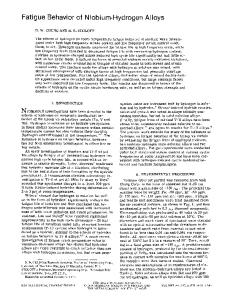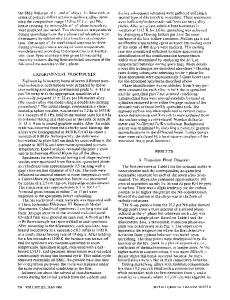Effect of niobium addition in FeCoNiCuNb x high-entropy alloys
- PDF / 1,038,105 Bytes
- 9 Pages / 584.957 x 782.986 pts Page_size
- 42 Downloads / 303 Views
FOCUS ISSUE
NANOCRYSTALLINE HIGH ENTROPY MATERIALS: PROCESSING CHALLENGES AND PROPERTIES
Effect of niobium addition in FeCoNiCuNbx high-entropy alloys Rahul M.R.1, Sumanta Samal2, Gandham Phanikumar1,a) 1
Department of Metallurgical and Materials Engineering, Indian Institute of Technology Madras, Chennai 600036, India Discipline of Metallurgy Engineering and Materials Science, Indian Institute of Technology Indore, Indore, Madhya Pradesh 453552, India a) Address all correspondence to this author. e-mail: [email protected] 2
Received: 20 August 2018; accepted: 23 January 2019
In the design of high-entropy alloys (HEAs) with desired properties, identifying the effects of elements plays an important role. HEAs with eutectic microstructure can be obtained by judiciously modifying the alloy compositions. In this study, the effect of Nb addition to FeCoNiCuNbx (x = 0.5, 5, 7.5, 11.6, 15) alloys was studied by varying the Nb concentration (at.%). FeCoNiCuNb0.5 HEA shows liquid phase separation to form Cu-rich and FeCoNiCu-rich phases. Detailed solidification paths are proposed for these alloys, which show eutectic, peritectic, and pseudo quasi-peritectic reactions. Increasing Nb content promotes the liquid phase separation tendency and causes the formation of Cu-rich spheres. The effect of Nb on the FeCoNiCu-rich phase was studied based on the nanoindentation and correlated with nanohardness. The compressive deformation properties of these alloys are studied at room temperature and high temperature and correlated with microstructure. Fractography results show the mode of fracture and are correlated with the microstructure obtained.
Introduction Alloys with five or more principal elements are designated as high-entropy alloys (HEAs), complex concentrated alloys (CCAs), etc., which explore the central region of the phase diagram. HEAs with remarkable properties like high toughness, fracture strength [1, 2], high strength [3], good ductility, better cryogenic properties [4], good corrosion resistance [5], etc., are explored in the literature and hence can be considered as potential candidates for critical applications [6]. HEAs can also be designed to obtain conventional as well as unique microstructure, which is suitable for different applications [7, 8]. It is reported in open literature that HEAs show better strength and ductility [8]. The phase evolution and solidification pathways are also reported in HEAs, which show unique microstructures, like eutectic [3, 9, 10], quasi-peritectic [11], and phase separation [12, 13, 14]. There are different criteria established in the literature to predict the phases and microstructure formation. These criteria include the atomic size difference, valence electron concentration, electronegativity difference, enthalpy of mixing, and entropy of mixing [3, 15, 16]. It is to be noted that the usage of these parameters are not applicable
ª Materials Research Society 2019
to all HEAs, which make the design of HEAs cumbersome. The usage of thermodynamic simulation using CAPHAD approach
Data Loading...










